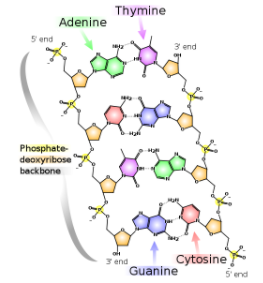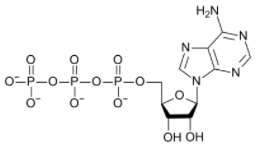12.3A: Phosphorus Functions
- Page ID
- 1560
Phosphorus has a number of functions in the body1. Phosphate is a component of hydroxyapatite in bones and teeth, as described earlier. Non-bone functions include:
Phosphorylation
Phosphates are used to activate and deactivate a number of proteins. In addition, compounds are also frequently phosphorylated, like the monosaccharides shown below.

Figure \(\PageIndex{1}\): Uptake of monosaccharides into the hepatocyte
Phospholipids
Phosphates are a component of phospholipids, as shown below.

Figure \(\PageIndex{2}\): Structure of phosphatidylcholine (lecithin)2
DNA/RNA
DNA/RNA have a phosphate backbone as shown below.

Figure \(\PageIndex{3}\): Structure of DNA3
ATP
The major energy currency, ATP, stores energy in its phosphate bonds.

Figure \(\PageIndex{14}\): Structure of ATP4
Secondary Messengers
The intracellular secondary messengers' cyclic AMP (cAMP) and inositol triphosphate (IP3) both contain phosphate. The action of these secondary messengers can be seen in the links below. Other functions of phosphate include:
- Acid/Base Balance
- Intracellular Anion
References & Links
- Gropper SS, Smith JL, Groff JL. (2008) Advanced nutrition and human metabolism. Belmont, CA: Wadsworth Publishing.
- commons.wikimedia.org/wiki/Fi...pc_details.svg
- ttp://en.Wikipedia.org/wiki/File:DN..._structure.svg
- en.Wikipedia.org/wiki/File:ATP_structure.svg
Links
- cAMP - courses.washington.edu/conj/g.../cyclicamp.htm
- IP3 - courses.washington.edu/conj/gprotein/ip3.htm


